Wondering what age to feed senior dog food to your beloved grey-muzzled friend? Worried you aren’t feeding your senior dog the right type or amount of food? If so, you aren’t alone! Integrative veterinarian Dr. Julie Buzby knows how daunting those decisions can be, which is why she created this handy senior dog feeding guide.
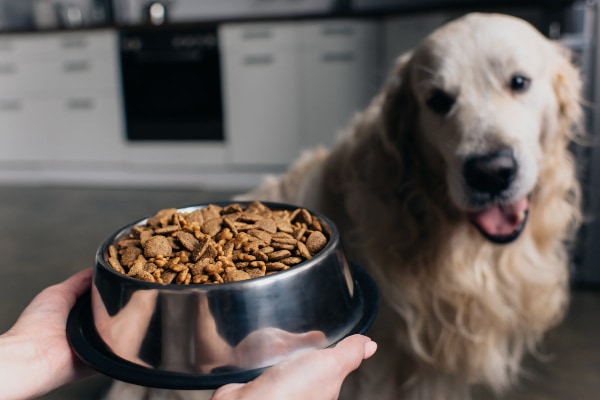
As a dog parent, you want to give your senior dog the very best of everything. This includes the food that he or she eats. But how do you even pick one? There are so many options on the market, each claiming to be just what your dog needs to live longer, stay healthier, and be happier.
At the end of the day, the decision of what food to feed your dog is between you, your dog, and your veterinarian. But I hope to be able to make things a bit clearer by sharing the same advice with you that I have shared with many of my clients—starting with why senior dog food is important for senior dogs.
Do I need to feed my dog senior food?
As you may know, different dog foods are suited for different stages of your dog’s life. For example, puppy food is great for puppies because it is optimized for growth. And adult dogs benefit from an “adult diet” that is lower in calories yet still provides essential nutrients for active dogs.
In the same way, many pet food companies produce diets specifically made for senior or “aging” dogs. Since older dogs may be less active than adults, commercial foods for senior dogs tend to have fewer calories than the adult or puppy versions.
Senior dog food may also contain additional ingredients to help address the unique needs of aging dogs. For example, many diets contain glucosamine and chondroitin or omega-3 fatty acids for dogs. These joint-support ingredients are beneficial because most older dogs will develop osteoarthritis in dogs at some point in their life. (However, it is important to note that—with a few exceptions— these foods typically don’t provide the same degree of joint support as joint supplements for dogs like Dr. Buzby’s Encore Mobility™ hip and joint supplement.)
For all these reasons, it is clear that senior dog food is a good choice for many senior dogs. But when you might ask, is the right time to make the switch from adult food to senior food? Well…the answer is that it depends on what constitutes a “senior dog.”
At what age should I feed my dog senior dog food?
Despite the old wives’ tale, figuring out when a dog is considered a senior isn’t as simple as saying that one human year equals seven dog years. It is true that your dog’s age can help determine when he or she is officially a senior. But it’s not the sole factor. Your dog’s overall size and breed will also play a role.
For example, vets may designate large breed dogs as seniors by the time they are six or seven years of age. Yet small breed dogs may not become seniors until they are ten or eleven years old.
Based on that information, you can often make an educated guess about when to start buying senior dog food. But sometimes, the best way to figure out at what age to feed senior dog food is to ask your veterinarian’s opinion.
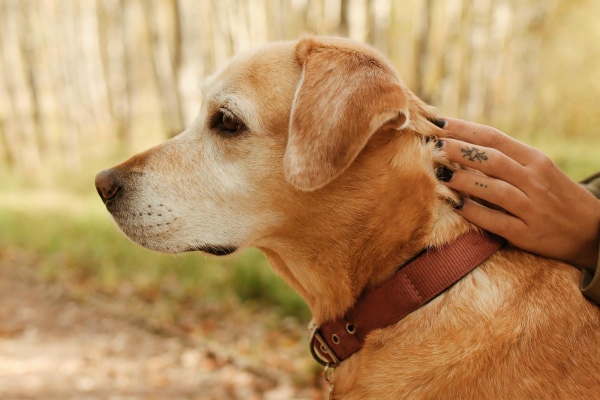
What is the best senior dog food?
Your veterinarian can also help you figure out which senior dog food is right for your dog. Having his or her input can be helpful because, as you have probably figured out, there are lots of food companies that boast about how their diets are the best. And some may make bold claims about what their food can do for your canine companion.
The advice of your veterinarian, plus the information I am about to share with you, can help you see beyond the marketing material and get to the heart of which food is best.
When evaluating senior dog foods, I like to start by looking at the AAFCO statements and the WSAVA nutritional assessment guidelines.
Evaluating the AAFCO statement
First, let’s break down the AAFCO statement. The Association of American Feed Control Officials (AAFCO) is a group of regulatory officials who set the standards for the safety and quality of pet foods in the United States. AAFCO does not endorse or certify specific diets. But they do ensure that a diet meets the nutritional requirements set forth by veterinary nutrition experts.
Adherence to those standards is expressed in the AAFCO statement, which is printed on the label of any diet sold in the United States. The AAFCO statement typically follows one of the following four formats:
- “XYZ Dog Food” is formulated to meet the nutritional levels established by the AAFCO Dog Food Nutrient Profiles for [appropriate life stage—growth, maintenance, gestation/lactation, or all life stages].
- Animal feeding tests using AAFCO procedures substantiate that “XYZ Dog Food” provides complete and balanced nutrition for [appropriate life stage].
- “XYZ Dog Food” provides complete and balanced nutrition for [appropriate life stage] and is comparable in nutritional adequacy to a product that has been substantiated using AAFCO feeding trials.
- This product is intended for intermittent or supplemental feeding only.
What does the AAFCO statement really mean?
The first AAFCO statement simply means that the recipe for the diet follows the guidelines set forth by AAFCO. But it doesn’t tell you much more than that. Does this diet just meet the bare minimum? Or does it go beyond following a simple recipe from a computer algorithm? There is no way to know based on that information alone.
This is where the second statement comes in. It indicates that the food company went the extra mile by conducting feeding trials to evaluate the health of dogs being fed those foods. This can help ensure that the foods perform well in real life, not just on a nutritional analysis.
The third statement isn’t as common, but may occasionally show up on foods that are very similar to the original food that underwent the feeding trial. For example, they may just have a minor change in the formulation that doesn’t affect the nutrition profile.
Finally, you may occasionally see the fourth statement on veterinary prescription diets. This is because it is sometimes necessary to drop or raise levels of a nutrient below the AAFCO Dog Food Nutrient Profile levels in order for the food to accomplish its intended goal. For example, a prescription kidney diet may intentionally contain lower phosphorus levels to help reduce the high blood phosphorus that may accompany kidney failure in dogs.
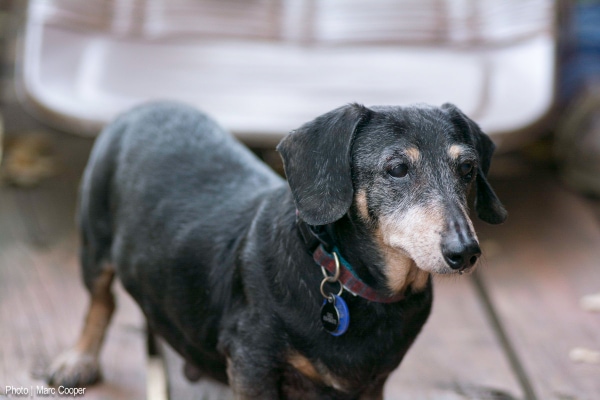
Using the WSAVA nutritional assessment guidelines
While the AAFCO statement is a great place to start, I also recommend taking a look at the WSAVA nutritional assessment guidelines. The World Small Animal Veterinary Association (WSAVA) is an international group of organizations that goes a step further than AAFCO.
Not only does WSAVA adhere to AAFCO’s guidelines for nutritional requirements, but they also set forth additional dietary standards such as food testing, company transparency, and input from veterinary nutritionists.
WSAVA’s nutritional assessment guidelines go into great detail about diets for dogs and what you should be looking for as a consumer. They even encourage dog parents to contact food manufacturers in order to ask pointed questions about the diets the manufacturer creates. You can find a comprehensive list of questions on WSAVA’s site. Here are a few examples of questions you may want to ask dog food manufacturers:
- Does your company have a veterinary nutritionist on staff? How can I contact them with questions?
- Where does your company produce and manufacture dog food?
- Does your company conduct research on your products? If so, are the results published in peer-reviewed journals? Where can I read this information?
Gathering information can help you feel even more confident that you are selecting a great food to help your senior dog thrive.
Feeding a senior dog: FAQs
Now that you know a bit more about when to feed your dog senior dog food and how to evaluate dog food, I want to address some more specific aspects of feeding senior dogs. To do this, I have collected and answered some of the most common frequently asked questions that I get from my clients.
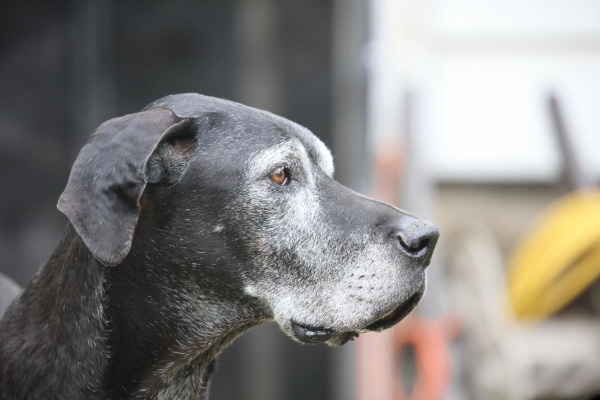
FAQ #1: Can I feed a senior dog puppy food?
It usually isn’t a big deal if your senior dog occasionally grabs a few mouthfuls of your puppy’s food. But remember that since puppy food is designed for growing puppies, it is calorie-dense. This means that it typically isn’t well suited for sedentary senior dogs as it is likely to make them gain weight. It also isn’t formulated to meet the needs of a senior dog. And in some cases, it may cause a bit of GI upset.
FAQ #2: What can I feed my senior dog to gain weight?
On the flip side, the fact that puppy food can pack on the pounds is sometimes useful for thin senior dogs. However, before you decide to switch to a higher-calorie food to help your dog gain weight, please make an appointment with your vet. Unexplained weight loss can be a common symptom of many medical conditions. And the sooner you start addressing the root of the problem the better.
Together, you and your vet can create a plan to help your dog feel better and gain weight. This often involves managing the underlying problem and adding more calories to the diet. Your vet will help you decide if feeding a higher-calorie food, feeding more of the same food, or some other strategy is right for your dog.
FAQ #3: How many times a day should I feed my senior dog?
Most veterinarians recommend that a senior dog be fed twice a day. However, some dogs do fine with once a day, three times a day, or grazing throughout the day.
Occasionally, there may be circumstances where your dog will need to be on a particular feeding schedule. For example, if your newly diabetic dog is used to eating once a day or having free access to food, he or she may need to switch to eating two times a day to correspond with twice-daily insulin administration.
It can be daunting to change a dog’s eating habits at first, but persistence is key. The veterinary team can also give you some tips if you are struggling with changing your dog’s routine.
FAQ #4: How much wet food or dry food should I feed my senior dog?
If you are unsure how much to feed your older dog, it is a good idea to check with your veterinarian. In some situations, he or she may recommend following the feeding guidelines on the bag or can of dog food. This approach tends to work fine for dogs who are already at a good weight.
Alternatively (and often ideally), your vet can help you determine a set amount of calories to aim for per day. When calculating this amount, the vet will take your dog’s body condition score (BCS) into account. Plus, he or she will consider your dog’s activity level, reproductive status, age, size, and medical conditions.
This allows your vet to customize the recommendations for your dog. For example, if you want to help your dog lose weight, your vet can tell you how much food to feed your dog to safely get down to the target weight. Or, if your senior dog needs to gain weight, the vet can adjust the calculation accordingly.
FAQ #5: What do you feed a senior dog with no appetite?
Some dogs can be naturally finicky eaters. It may seem like your furry friend is holding out for something better—like whatever you might be eating! But keep in mind that a lack of appetite can indicate underlying health issues. Therefore, it is best to schedule an appointment with your vet if your dog suddenly becomes a picky eater.

In addition to treating the underlying problem (if there is one) the vet may make the following suggestions:
- Warm up canned food in the microwave for a few seconds to make it more palatable
- Administer appetite stimulants for dogs
- Offer your dog some baby food meat (Keep in mind that baby foods are not complete and balanced sources of nutrition for dogs. Thus, long-term use may negatively affect your dog’s health.)
- Add water to dry food to make gravy or top it with something tasty like canned pumpkin for dogs
- Try hand-feeding your dog
FAQ #6: What can I feed a senior dog with diarrhea or other digestive issues?
If you have a senior dog with digestive issues, specifically formulated foods can help them feel better. Some dogs may need highly digestible proteins like those found in various bland diets for dogs. Other dogs may benefit from a low-fat diet such as those designed to feed a dog with pancreatitis. Yet other senior dogs, especially those with diarrhea, have improved stool quality when their diet contains more fiber for dogs.
Your vet can help you find the right diet, medication, and/or supplement to help your dog’s tummy troubles. Please give him or her a call before you reach for the Pepto-Bismol for dogs or any other medications.
FAQ #7: What do I feed a senior dog with no teeth?
If your older dog is losing teeth due to dental disease in dogs, or recently underwent a senior dog tooth extraction, you may need to modify his or her diet. Your veterinarian can give you more specifics. But in general, these dogs benefit from a canned or softened diet. Your vet may recommend adding water to the dry kibble or simply switching to canned food. Sometimes this is a temporary measure while the mouth heals and other times it is a permanent change.
FAQ #8: Can a special diet help manage my dog’s health problems?
As dogs age, health problems become more common. However, with proper nutrition, you may be able to lessen the intensity of a dog’s symptoms. Or you may be able to slow the progression of certain diseases.
For example, chronic kidney disease is a common issue in many senior dogs. Diets that are high in protein, phosphorus, and sodium can speed up damage to the kidneys. Plus, they can increase the chance of having high blood pressure (i.e. hypertension in dogs). Therefore, your vet may recommend a prescription or homemade diet that is lower in those nutrients.
There are also prescription diets that can help with:
- Liver disease in dogs
- Diabetes in dogs
- Canine cognitive dysfunction (i.e. doggie dementia)
- Signs of arthritis in dogs
- Bladder stones in dogs
- Pancreatitis in dogs
- Food allergies
- And more!
FAQ #9: What if I’m struggling to afford a senior diet for my dog?
Cost can be a significant factor when it comes to choosing a senior dog food (or any dog food). And understandably, you may wonder if your dog really needs a senior diet. In truth, all seniors can glean benefits from being fed senior diets, but there are some older pups who can thrive on adult dog food for a long time. These are typically active seniors with no ongoing health issues.
Also, there are many food companies that carry an extensive line of products to fit almost any budget. For example, Purina’s highest-tier food is Pro Plan, but they also know that not everyone can afford to feed this food. This is why Purina also produces Purina Dog Chow. Because this line of food is not targeted toward a particular life stage, it costs less than Pro Plan yet still has high-quality ingredients.
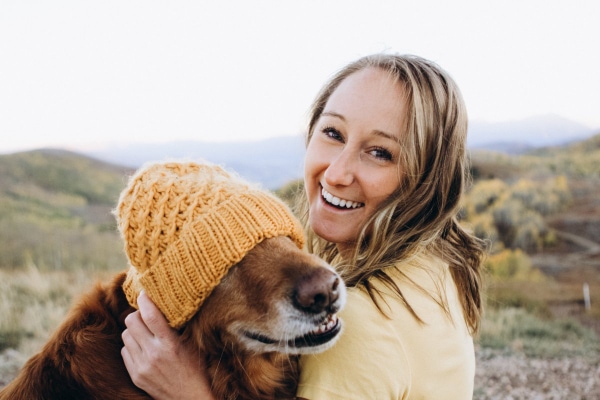
Work with your veterinarian
It probably goes without saying, but your veterinarian makes a fantastic resource when picking food. He or she knows your dog’s medical history and can help you figure out at what age to feed senior dog food, what kind of food to get, how much to feed your dog, and how often. Plus, he or she can give you other recommendations to keep your senior dog happy and healthy.
Also, while you are browsing in the pet store (or online) remember what I told you about using the standards set forth by AAFCO and WSAVA. They are great tools for evaluating the dog foods you are interested in and selecting the best one for your dog.
Feeding your senior dog can feel a bit daunting, but I know you can do it. Use what you have learned here, and don’t be afraid to ask for help from your vet if you need it!
When did you start feeding your dog senior dog food?
Please comment below.


Hello again,
I failed to include the following text in my earlier comment about losing our Shih Tzu dog.
One of the things we are most guilty about is not being with our dog when he was euthanized. We were called at 2 AM and in our grief of hearing his body was shutting down, we decided we weren’t emotionally able to see him suffering, so we didn’t go to the emergency vet clinic before he was euthanized. As we read articles about the importance of pet owners being with their pets immediately before euthanasia, we are filled with incredible guilt that we let him die alone—and it’s heartbreaking for us. In hindsight, we have deep regrets for not being there for him. We try to tell ourselves that we were emotionally drained and at 2 AM in the morning, we didn’t give the decision enough thought before deciding not to see him again. We wonder how he was feeling, being in a strange place with strangers, being poked and prodded in attempts to save his life. He probably would have been comforted if he had seen us one more time, even though it would have been more difficult for us to see him in such a sad condition. Did he feel like we abandoned him? Did he realize we tried everything we could to save his life and make him comfortable? At times, we are consumed with these thoughts. We wish we knew how he felt about us in his final hours.
Hello,
Our 10-year-old Shih Tzu male was diagnosed with diabetes in November 2022. For several weeks, our vet tried to adjust his insulin to manage his glucose levels but was unsuccessful. In early December he started yelping in pain when he moved his head/neck. The vet x-rayed his shoulder and neck and diagnosed him with a pulled neck muscle (he had just been to the groomer and in hindsight are suspicious that he fell off the grooming table, but we’ll never know for sure); the vet put him on pain meds and a muscle relaxant. But after 2 weeks his occasional yelping turned to crying in severe pain for several seconds. At my insistence the vet took another x-ray of his neck and discovered he had a broken jaw. We were stunned that she had missed it for over 2 weeks. He underwent surgery to set his jaw, and although he was alert and active after the surgery, that was the beginning of the end for him—he never recovered. The vet put a fentanyl patch on him for pain and over the course of the next 10 days, he had another patch applied when the first patch expired. Because we were going into the long New Year’s weekend, the vet removed the second patch that would expire on January 1st and applied a third patch—she assured us the fentanyl in the patch was a timed, slow release and he wouldn’t be overdosed. We took him to the emergency vet clinic on New Year’s Eve because he couldn’t stand up and was having trouble breathing. In the wee hours of January 2nd, they called to tell us his organs were failing; at the vet’s recommendation, we reluctantly had to euthanize him. We were (and are) devasted; he went from him being a relatively full-of-life dog to death in a few short days and we are second guessing ourselves about euthanizing him too soon. We wonder if he was overdosed on the fentanyl patches and that the emergency clinic’s vet misinterpreted an overdose as his body shutting down for other reasons. Afterwards, we had our primary vet review the test results from the emergency vet clinic and she assured us that we made the right decision. But we are overcome with grief and guilt and continue to second guess our decision. We are both retired, and he was the center of our lives for 10 years—we cling to the hope that we did the right thing for him, but the second-guessing and guilt are overwhelming at times. We need to move on with our lives, but our puppy is no longer part of our future. He was our “perfect dog” and we can’t imagine we’ll find another dog as sweet and loving as him. We realize you don’t have access to his test results as he neared the end, but can you perhaps give us some encouragement that we did what was best for him? We are very sad.
Thank you for any help and feedback you can give us.
Dear Dave,
First let me say I am so sorry for the loss of your senior boy. I can only imagine how much you must miss him. I will do my best to offer information and shed some light on this tragic situation. Without being a part of your dog’s medical care, I can’t make specific conclusions, but I can give you my honest thoughts. I was surprised to hear your pup sustained a fractured jaw. I completely understand how this could have been missed initially as the symptoms would not have made me think to look for that particular injury. I would have suspected your dog to be painful when eating and refusing his food instead of occasionally crying out when moving his neck. It was very lucky your vet had enough of the skull in view when taking the neck radiographs that they were able to diagnose the jaw fracture. Your vet is correct that the fentanyl patches are a timed slow release and once removed should not continue to provide any of the drug into your dog’s system. Now these patches can be a bit tricky. There is possibility for an overdose if a dog licks the patch, or if the patches are warmed or near a heat source. The addition of warming or heat will increase the absorption rate of the medication from the patch through the skin. Was there any chance your pup was sleeping near a heat vent, a fireplace, or under a warm blanket/electric blanket? The symptoms you described of your dog being weak and having trouble breathing could be signs of an overdose, but not necessarily. Also, I did some research on fentanyl overdoses in dogs just to make sure I didn’t give false information, and I did not see any mention of it causing lab work abnormalities or organ failure. All instances of overdoses that I read only described rapid heart rate, difficulty breathing, and seizures. I am puzzled as to why your sweet boy went into organ failure and it sounds like the emergency vet was just as surprised by this turn of events. I am not sure we will ever know what happened but hear me when I say you did everything you could to give your pup the best chance at life. I would have made all the same choices and don’t see where I would have done anything differently. Also, I did see your follow up comment and will approve it to be attached below. Please don’t carry the burden of guilt over not being with your boy during his last moments. It is clear he was dearly loved, and I have no doubt he knew. From what you described; he was probably not aware of his surroundings at the end. I do not think the lack of your presence made the experience a negative one or added any level of worry on his part. I am glad you made a choice to spare yourself from an emotional and troubling memory that you would have to think about going forward. Just because being present works for some people doesn’t make it the right choice for everyone. Each person is different, and you have to know what is best for yourself. I am confident the veterinary team was there to love on your sweet boy, and he was surrounded by caring arms while he passed. He was not alone. I hope with time you will allow yourself some grace and your heart can begin to heal. May your pup’s memory be a blessing that stays with you forever. Wishing you the best for happier days ahead. ♥